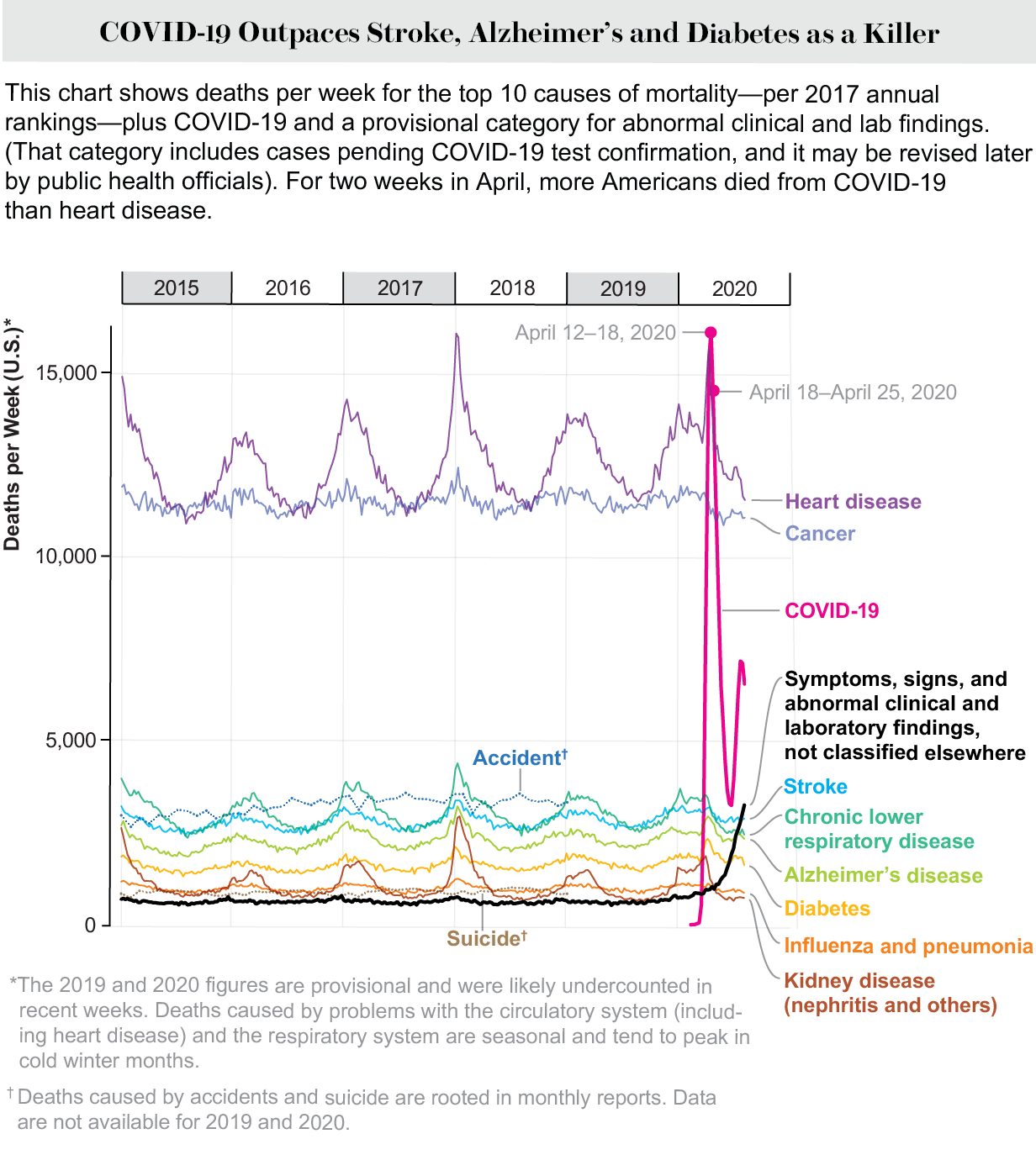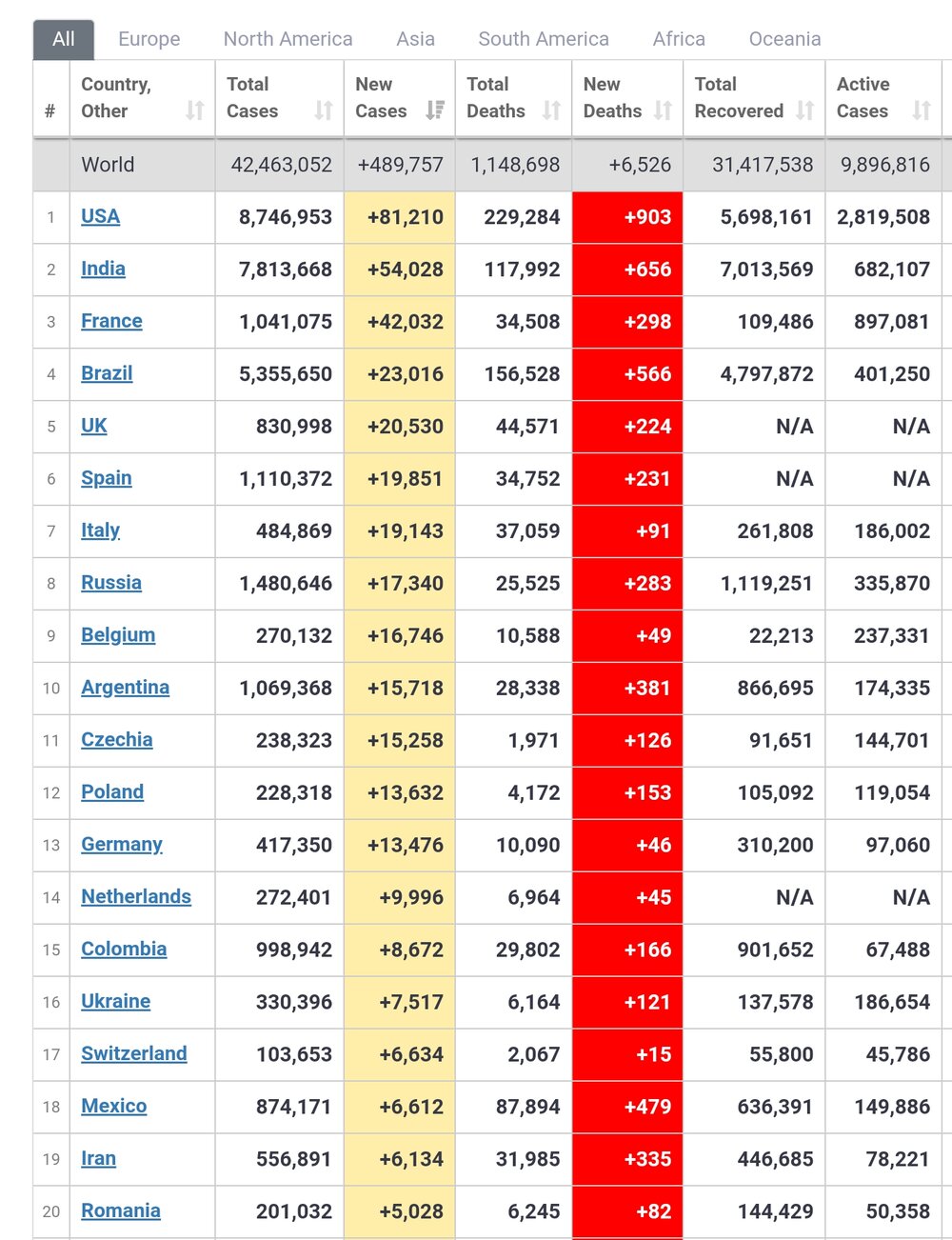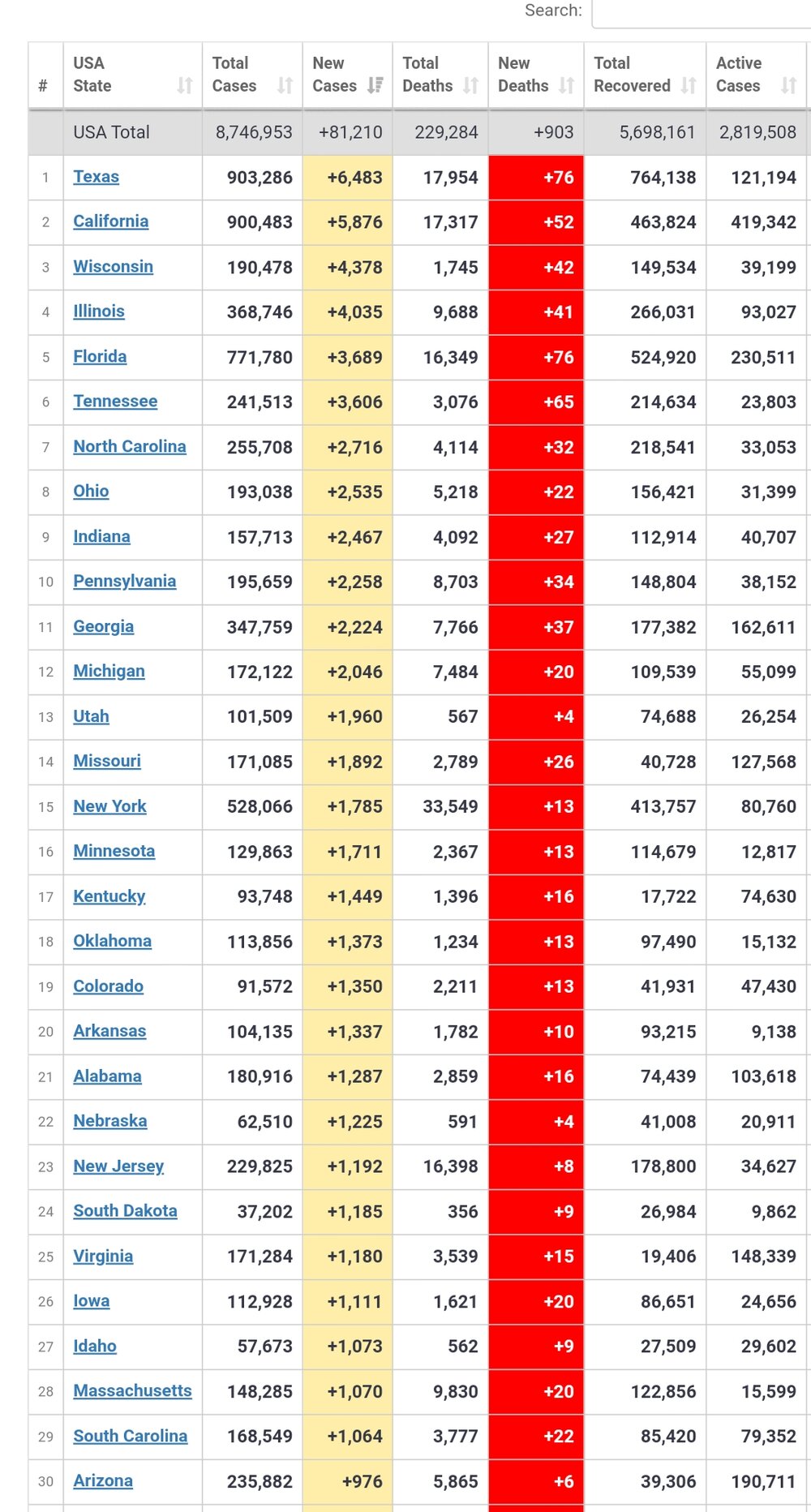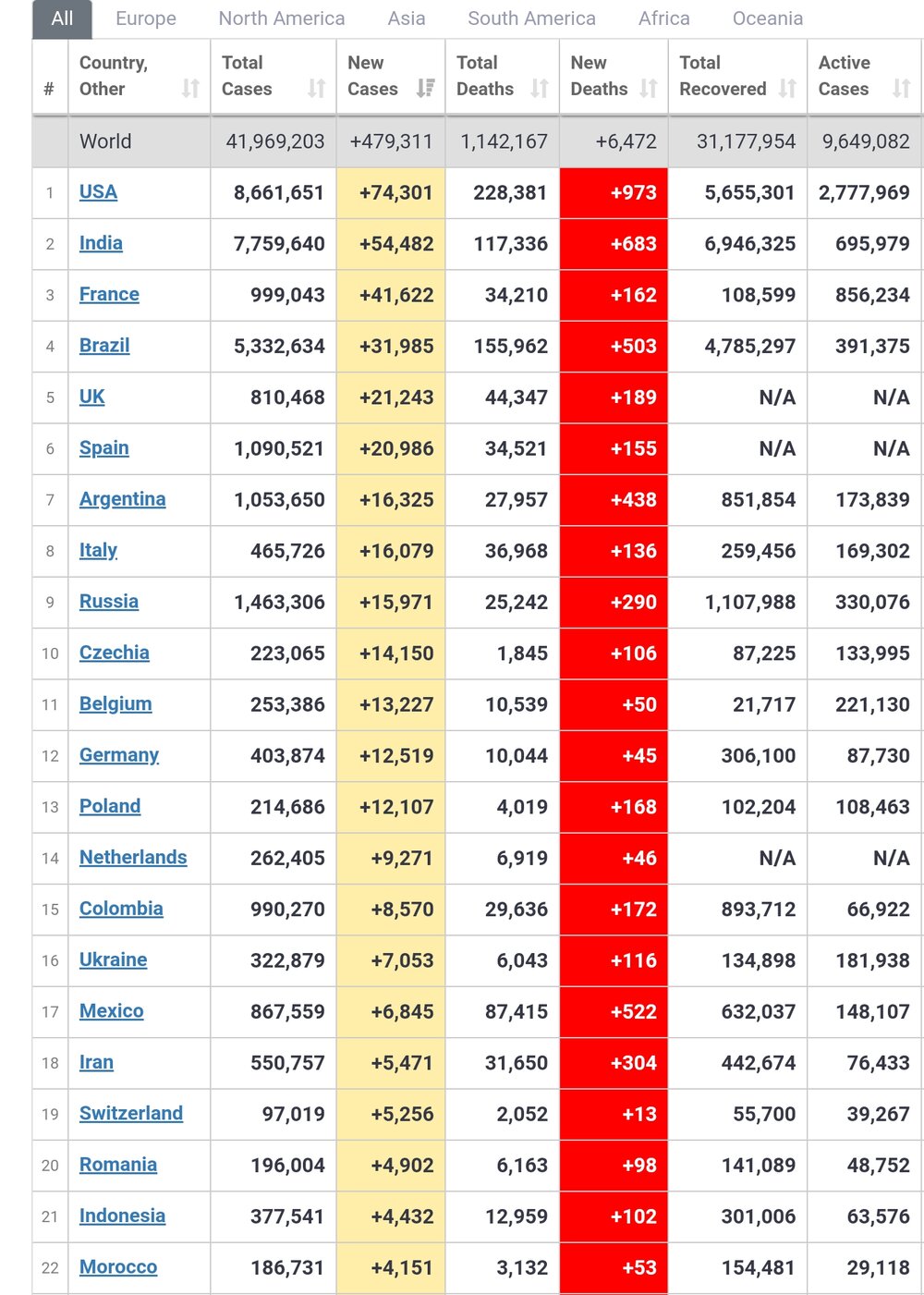You are using an out of date browser. It may not display this or other websites correctly.
You should upgrade or use an alternative browser.
You should upgrade or use an alternative browser.
AD1184
Celestial
In Britain's case, it is because there is no data collection on recoveries. There is however daily reporting on the number of people in hospital with Covid-19.These are yesterday's numbers, doesn't look good for the West, also curious as to why UK and Spain aren't reporting active cases...
View attachment 11480
nivek
As Above So Below
Debunking the False Claim That COVID Death Counts Are Inflated
A persistent falsehood has been circulating on social media: the number of COVID deaths is much lower than the official statistic of more than 218,000, and therefore the danger of the disease has been overblown. In August President Trump retweeted a post claiming that only 6 percent of these reported deaths were actually from COVID-19. (The tweet originated from a follower of the debunked conspiracy fantasy QAnon.) Twitter removed the post for containing false information, but fabrications such as these continue to spread. U.S. Representative Roger Marshall of Kansas complained in September that Facebook had removed a post in which he claimed that 94 percent of COVID-19 deaths reported by the Centers for Disease Control and Prevention “were the result of 2-3 additional serious illnesses and were of advanced age.”
Now some facts: Researchers know beyond a doubt that the number of COVID-19 deaths in the U.S. have surpassed 200,000. These numbers are supported by three lines of evidence, including death certificates. The inaccurate idea that only 6 percent of the deaths were really caused by the coronavirus is “a gross misinterpretation” of how death certificates work, says Robert Anderson, lead mortality statistician at the CDC’s National Center for Health Statistics.
The scope of the coronavirus’s deadly toll is clear, even if final numbers will not be known until the pandemic is over. “We’re pretty confident about the scale and order of magnitude of deaths, but we’re not clear on the exact number yet,” says Justin Lessler, an infectious disease epidemiologist at the Johns Hopkins Bloomberg School of Public Health. To understand why the figures contain some uncertainty, it is important to know how they are collected and calculated.
The first source of death data is called case surveillance. Health care providers are required to report cases and deaths from certain diseases, including measles, mumps and now COVID-19, to their state’s health department, which, in turn, passes this information along to the CDC, Anderson says. The surveillance data are a kind of “quick and dirty” accounting, says Shawna Webster, executive director of the National Association for Public Health Statistics and Information Systems. The states gather all the information they can on these diseases, but this is the first pass of the accounting—no one has time to double-check the information or look for missing lab tests, she says. For that, you have to look for the next source of information: vital records.

This second line of evidence comes from the National Vital Statistics System, which records birth and death certificates. When somebody dies, a death certificate is filed in the state where the death occurred. And after the records are registered at a state level, they are sent to the National Center for Health Statistics, which tracks deaths at a national level. Death certificates are not filed in the system until outstanding test results are in and the information is as complete as possible. By the time a record gets to the vital records system, “it is as close to perfect as it’s going to get,” Webster says.
A physician, medical examiner or coroner fills out the cause of mortality on the death certificate, and they are instructed to include only those conditions that caused or contributed to death, Anderson says. One field lists the sequence of events leading to the death. “What we’re really trying to get at is the condition or disease that started the chain of events leading to the death,” Anderson says. “For COVID-19, that might be something like acute respiratory distress due to pneumonia due to COVID-19.” A second part of the certificate lists other significant conditions that may have contributed to the death yet were not part of the sequence of events that led up to it, he says. These are called comorbidities, and while they can be contributing factors, they cannot be directly involved in the chain of cause and effect that ended in death. Preexisting medical conditions such as diabetes or heart disease are common comorbidities, and they can make a person more vulnerable to the coronavirus, Anderson says, “but the fact is: they’re not dying from that preexisting condition.”
“When we ask if COVID killed somebody, it means ‘Did they die sooner than they would have if they didn’t have the virus?’” Lessler says. Even such a person with a potentially life-shortening preexisting condition such as heart disease or diabetes may have lived another five, 10 or many more years, had they not become infected with COVID-19.
The 6 percent number touted by Trump and QAnon comes from a weekly CDC report stating that in 6 percent of the coronavirus mortality cases it counted, COVID-19 was the only condition listed on the death certificate. That observation likely means that those death certificates were incomplete because the certifiers only gave the underlying cause of death and not the full causal sequence that led to it, Anderson says. Even someone who does not have a preexisting condition and dies from COVID-19 will also have comorbidities in the form of symptoms, such as respiratory failure, caused by the coronavirus. The idea that a death certificate with ailments listed in addition to COVID-19 means that the person did not really die from the virus is simply false, Anderson says.
The surveillance and vital statistics data provide a pretty good picture of how many deaths are attributable to the coronavirus, but they do not capture all of them, and that is where the final line of evidence come in: excess deaths. They are the number of deaths that occur above and beyond the historical pattern for that time period, says Steven Woolf, a physician and population health researcher at the Virginia Commonwealth University School of Medicine. In a paper published in JAMA this month, Woolf and his colleagues examined death records in the U.S. from March 1 through August 1 and compared them with the expected mortality numbers. They found that there was a 20 percent increase in deaths during this time period—for a total of 225,530 excess deaths—compared with previous years.
Two thirds of these cases were attributed to COVID-19 on the death certificates, and Woolf says there are two types of explanations for the rest: Some of them were COVID-19 deaths that simply were not documented as such, perhaps because the person died at home and was never tested or because the certificate was miscoded. And some of the extra deaths were probably a consequence of the pandemic yet not necessarily the virus itself. For instance, he says, imagine a patient with chest pain who is scared to go to the hospital because they do not want to get the virus and then dies of a heart attack. Woolf calls this “indirect mortality.” “The deaths aren’t literally caused by the virus itself but the pandemic is claiming lives,” he says.
The numbers in Woolf’s study come from provisional death data, the kind that the CDC has not yet checked for miscoding or other issues, so it comes with some degree of imprecision. What builds his confidence in these results, however, is the fact that they have been replicated numerous times by his group and others. “All serious analyses of these data are showing that the number of deaths we’re hearing on the news is an undercount,” he says.
COVID-19 is now the third leading cause of death in the U.S. Whether the deaths add up to 218,511, 219,681 or 219,541—as reported by the CDC, Johns Hopkins University and the New York Times, respectively, on October 19—it’s a staggering number of lives cut short.
.
A persistent falsehood has been circulating on social media: the number of COVID deaths is much lower than the official statistic of more than 218,000, and therefore the danger of the disease has been overblown. In August President Trump retweeted a post claiming that only 6 percent of these reported deaths were actually from COVID-19. (The tweet originated from a follower of the debunked conspiracy fantasy QAnon.) Twitter removed the post for containing false information, but fabrications such as these continue to spread. U.S. Representative Roger Marshall of Kansas complained in September that Facebook had removed a post in which he claimed that 94 percent of COVID-19 deaths reported by the Centers for Disease Control and Prevention “were the result of 2-3 additional serious illnesses and were of advanced age.”
Now some facts: Researchers know beyond a doubt that the number of COVID-19 deaths in the U.S. have surpassed 200,000. These numbers are supported by three lines of evidence, including death certificates. The inaccurate idea that only 6 percent of the deaths were really caused by the coronavirus is “a gross misinterpretation” of how death certificates work, says Robert Anderson, lead mortality statistician at the CDC’s National Center for Health Statistics.
The scope of the coronavirus’s deadly toll is clear, even if final numbers will not be known until the pandemic is over. “We’re pretty confident about the scale and order of magnitude of deaths, but we’re not clear on the exact number yet,” says Justin Lessler, an infectious disease epidemiologist at the Johns Hopkins Bloomberg School of Public Health. To understand why the figures contain some uncertainty, it is important to know how they are collected and calculated.
The first source of death data is called case surveillance. Health care providers are required to report cases and deaths from certain diseases, including measles, mumps and now COVID-19, to their state’s health department, which, in turn, passes this information along to the CDC, Anderson says. The surveillance data are a kind of “quick and dirty” accounting, says Shawna Webster, executive director of the National Association for Public Health Statistics and Information Systems. The states gather all the information they can on these diseases, but this is the first pass of the accounting—no one has time to double-check the information or look for missing lab tests, she says. For that, you have to look for the next source of information: vital records.

This second line of evidence comes from the National Vital Statistics System, which records birth and death certificates. When somebody dies, a death certificate is filed in the state where the death occurred. And after the records are registered at a state level, they are sent to the National Center for Health Statistics, which tracks deaths at a national level. Death certificates are not filed in the system until outstanding test results are in and the information is as complete as possible. By the time a record gets to the vital records system, “it is as close to perfect as it’s going to get,” Webster says.
A physician, medical examiner or coroner fills out the cause of mortality on the death certificate, and they are instructed to include only those conditions that caused or contributed to death, Anderson says. One field lists the sequence of events leading to the death. “What we’re really trying to get at is the condition or disease that started the chain of events leading to the death,” Anderson says. “For COVID-19, that might be something like acute respiratory distress due to pneumonia due to COVID-19.” A second part of the certificate lists other significant conditions that may have contributed to the death yet were not part of the sequence of events that led up to it, he says. These are called comorbidities, and while they can be contributing factors, they cannot be directly involved in the chain of cause and effect that ended in death. Preexisting medical conditions such as diabetes or heart disease are common comorbidities, and they can make a person more vulnerable to the coronavirus, Anderson says, “but the fact is: they’re not dying from that preexisting condition.”
“When we ask if COVID killed somebody, it means ‘Did they die sooner than they would have if they didn’t have the virus?’” Lessler says. Even such a person with a potentially life-shortening preexisting condition such as heart disease or diabetes may have lived another five, 10 or many more years, had they not become infected with COVID-19.
The 6 percent number touted by Trump and QAnon comes from a weekly CDC report stating that in 6 percent of the coronavirus mortality cases it counted, COVID-19 was the only condition listed on the death certificate. That observation likely means that those death certificates were incomplete because the certifiers only gave the underlying cause of death and not the full causal sequence that led to it, Anderson says. Even someone who does not have a preexisting condition and dies from COVID-19 will also have comorbidities in the form of symptoms, such as respiratory failure, caused by the coronavirus. The idea that a death certificate with ailments listed in addition to COVID-19 means that the person did not really die from the virus is simply false, Anderson says.
The surveillance and vital statistics data provide a pretty good picture of how many deaths are attributable to the coronavirus, but they do not capture all of them, and that is where the final line of evidence come in: excess deaths. They are the number of deaths that occur above and beyond the historical pattern for that time period, says Steven Woolf, a physician and population health researcher at the Virginia Commonwealth University School of Medicine. In a paper published in JAMA this month, Woolf and his colleagues examined death records in the U.S. from March 1 through August 1 and compared them with the expected mortality numbers. They found that there was a 20 percent increase in deaths during this time period—for a total of 225,530 excess deaths—compared with previous years.
Two thirds of these cases were attributed to COVID-19 on the death certificates, and Woolf says there are two types of explanations for the rest: Some of them were COVID-19 deaths that simply were not documented as such, perhaps because the person died at home and was never tested or because the certificate was miscoded. And some of the extra deaths were probably a consequence of the pandemic yet not necessarily the virus itself. For instance, he says, imagine a patient with chest pain who is scared to go to the hospital because they do not want to get the virus and then dies of a heart attack. Woolf calls this “indirect mortality.” “The deaths aren’t literally caused by the virus itself but the pandemic is claiming lives,” he says.
The numbers in Woolf’s study come from provisional death data, the kind that the CDC has not yet checked for miscoding or other issues, so it comes with some degree of imprecision. What builds his confidence in these results, however, is the fact that they have been replicated numerous times by his group and others. “All serious analyses of these data are showing that the number of deaths we’re hearing on the news is an undercount,” he says.
COVID-19 is now the third leading cause of death in the U.S. Whether the deaths add up to 218,511, 219,681 or 219,541—as reported by the CDC, Johns Hopkins University and the New York Times, respectively, on October 19—it’s a staggering number of lives cut short.
.
AD1184
Celestial
The devolved Welsh government has gone power mad.
nivek
As Above So Below
Not a good day, the US has over 80k new cases today, France and the UK hitting new high numbers, the worst thing about this to me is that soon the death counts will begin climbing faster, if the past spikes earlier in the year are any indication...Unfortunately we may be in for a long dark winter, let's hope not...
Here's the top ten countries and now there's 29 states in the US with over a 1000 new infections in one day...


Here's the top ten countries and now there's 29 states in the US with over a 1000 new infections in one day...


Last edited:
nivek
As Above So Below
The devolved Welsh government has gone power mad.
More images of Wales locking down...
nivek
As Above So Below
Now 48 deaths from the flu shot, what the frak is going on?...
...
South Korean authorities stick to flu vaccine plan after deaths rise to 48
The number of South Koreans who have died after getting flu shots has risen to 48, the Korea Disease Control and Prevention Agency (KDCA) said on Saturday, adding that the vaccines would continue to reduce the chance of having simultaneous epidemics.
The health authorities said they found no direct link between the deaths and the shots. They plan to carry on with the state-run vaccination program to try to avoid having to fight both the flu and the coronavirus over the coming winter.
"After reviewing death cases so far, it is not the time to suspend a flu vaccination program since vaccination is very crucial this year, considering ... the Covid-19 outbreaks," KDCA Director Jeong Eun-kyung told a briefing.
Jeong said the review had shown no direct link between the flu shots and the 26 deaths that have been investigated.
Some 20 initial autopsy results from the police and the National Forensic Service showed that 13 people died of cardiovascular, cerebrovascular and other disorders not caused by the vaccination.
The death toll among those who have been vaccinated rose by 12 cases from a day earlier to 48 on Saturday.
The rising deaths have caused some doctors and politicians to call for a halt to the government campaign to vaccinate about 30 million of the country's 54 million people.
While encouraging people to get flu vaccines, Jeong issued precautions to take before getting the shot, such as drinking enough water and telling healthcare workers about any underlying medical conditions. She also advised people to wait 15-30 minutes before leaving the clinic where they receive their vaccine.
"If possible, try to get the flu shot when it's warm, since there are concerns that low temperatures could affect cardiovascular disease or cerebrovascular disease," she said.
The KDCA said 9.4 million people had been inoculated as of Friday in the program that began in September, with 1,154 cases of adverse reactions.
(More on the link)
.
AD1184
Celestial
Out of how many people, in total? What was the expected number of deaths for the same number of people in the same time frame without the flu shot?Now 48 deaths from the flu shot, what the frak is going on?...
nivek
As Above So Below
Out of how many people, in total? What was the expected number of deaths for the same number of people in the same time frame without the flu shot?
The last paragraph gave these numbers below, so are there known and acceptable numbers of people a year who die from getting the flu shot?...
The KDCA said 9.4 million people had been inoculated as of Friday in the program that began in September, with 1,154 cases of adverse reactions.
...
AD1184
Celestial
The article says 'died after', not 'died from'. It doesn't give a common proximal cause (or causes) of death, nor does it establish a mechanism of how this is related to the flu shot. The same article says that the South Korean authorities have found no direct link between the vaccine and the deaths. In a collection of 9.4 million people in a country like South Korea, I would expect a few hundred of them to die every day on average, in an average year, not to mention that those who are more vulnerable--and therefore at increased risk of dying--are likely prioritized to receive the vaccine first.
AD1184
Celestial
According to this Korean government page, the crude death rate in South Korea in 2019 was 574.8 per 100,000 population.The last paragraph gave these numbers below, so are there known and acceptable numbers of people a year who die from getting the flu shot?
Statistics Korea
Therefore in a random sample of 9.4 million South Koreans, we would expect 148 of them to die every day. So if there have only been 48 deaths in total since they all got the vaccine I have to ask, was it drawn from the Fountain of Eternal Youth, or something?
nivek
As Above So Below
According to this Korean government page, the crude death rate in South Korea in 2019 was 574.8 per 100,000 population.
Statistics Korea
Therefore in a random sample of 9.4 million South Koreans, we would expect 148 of them to die every day. So if there have only been 48 deaths in total since they all got the vaccine I have to ask, was it drawn from the Fountain of Eternal Youth, or something?
So these recent flu deaths seem to be used more as media hype than than anything else...
...
AD1184
Celestial
Credited at the bottom to 'MonkeyIlluminati.com'. I visited that website. It seems to be some kind of joke website.This is making rounds on social media in attempts to lay the blame of these pandemics to our technology...
...
View attachment 11514
Last edited:
nivek
As Above So Below
Back in February when covid was just ramping up I was all for locking down everything to stymie the spread of infection, but I also thought the entire country would also be on that page, they weren't...Some states did lock down whilst others did not, with mixed results but ultimately ineffective, who knows if there was a 100% lock down of the country whether it would have worked or not...Now we are facing a worse situation than earlier in the year, but my mind has changed about these lockdowns...I am against locking down anything anymore, we must keep all the shops and businesses open, let them adapt to social distancing and occupancy limits through the rest of this pandemic, but let them remain open...If we keep locking down we are going to do irreparable damage to our economy and western society as a whole...Masks and social distancing definitely must continue and anything else we can do to minimize exposure and the spread of covid, but no more locking down...
...
...


